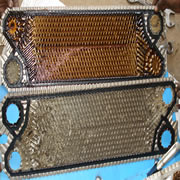Plate finned type Heat Exchanger
Introduction
Tipo Plate finned type Heat Exchanger is often categorized as a compact heat exchanger to emphasise its relatively high heat transfer surface area to volume ratio. A plate-fin heat exchanger is a type of heat exchanger design that uses plates and finned chambers to transfer heat between fluids. The plate-fin heat exchanger is widely used in many industries, including the aerospace industry for its compact size and lightweight properties, as well as in cryogenics ability to facilitate heat transfer with small temperature differences is utilized. Plate-fin heat exchangers are generally applied in industries fluids have little chances of fouling. The delicate design as well as the thin channels in the plate-fin heat exchanger makes cleaning difficult or impossible.
Product Description:-
Plate-fin heat exchanger of flexibility is present in plate-fin heat exchanger design as they can operate with any combination of gas, liquid, two-phase fluids. Heat transfer between multiple process streams is also accommodated, with a variety of fin heights and types as different entry & exit points available for each stream. plate-fin heat exchanger four type of fins are: plain, which refer to simple straight-finned triangular or rectangular designs; herringbone, where the fins are placed sideways to provide a zig-zag path; and serrated and perforated which refer to cuts and perforations in the fins to augment flow distribution & improve heat transfer.
Specifications of Plate Finned Type Heat Exchanger:
- A plate-fin heat exchanger is made of layers of corrugated sheets separated by flat metal plates, typically aluminium, to create a series of finned chambers. Separate hot and cold fluid streams flow through alternating layers of the heat exchanger and are enclosed at the edges by side bars.
Applications of Plate Finned Type Heat Exchanger:
- High thermal effectiveness & close temperature approach. Temperature approach as low as 3K between single phase fluid streams & 1K between boiling & condensing fluids is fairly common.
- True counter-flow operation unlike the shell and tube heat exchanger, where the shell side flow is usually a mixture of cross and counter flow.
- Large heat transfer surface area per unit volume and Low weight, Multi-stream operation Up to ten process streams can exchange heat in a single heat exchanger.
Advantages of Plate Type Heat Exchanger:
- A plate-fin heat exchanger one stream through the fin interface to the separator plate and through the next set of fins into the adjacent fluid. The fins also serve to increase the structural integrity of the heat exchanger and allow it to withstand high pressures while providing an extended surface area for heat transfer.
Images:


